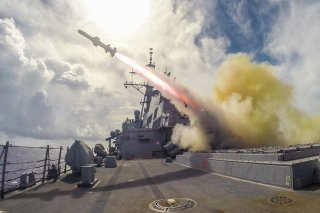Lockheed Martin’s First Mach 5 Monster Hypersonic Weapon Is Almost Here
How do you defend against them?
Here's What You Need to Remember: The impact of hypersonic weapons pertains almost entirely to a self-evident, yet crucial variable: speed. U.S. aircraft carriers, troop fortifications, weapons installations, moving armored convoys and even international continental ballistic missiles (ICBMs) could be destroyed in minutes if not seconds.
Lockheed Martin has unveiled the first images of its new Long Range Hypersonic Weapon. This offers an initial glimpse of a new missile able to travel sixty-miles per minute at speeds of Mach 5, skim along the upper edge of the earth’s atmosphere, and descend upon enemy targets with unprecedented force and speed.
Expected to be ready for war by 2023, the new weapon is intended to not only bring new dimensions to warfare but also ensure Americas keeps pace, or stays in front of, rival nations known to have hypersonic weapons.
“The new weapon system will consist of four transporter erector launchers (TEL), each installed on a modified M870 40-ton trailer, and command posts. Each TEL will have two canisterized hypersonic weapons at the ready and the unit will have an unspecified number of additional missiles on hand,” a report from Defence Blog states.
The advantages of these weapons are both self-evident and multi-faceted; they include much greater stand-off ranges for attack as well as a vastly increased ability to defeat, circumvent or even destroy enemy defenses.
The impact of hypersonic weapons pertains almost entirely to a self-evident, yet crucial variable: speed. U.S. aircraft carriers, troop fortifications, weapons installations, moving armored convoys and even international continental ballistic missiles (ICBMs) could be destroyed in minutes if not seconds. This means countermeasures, defenses or responses may simply not have time to take shape or operate.
A former Air Force Chief Scientist told me that hypersonic weapons development can be thought of in almost a “stair-step” fashion, with new iterations or incremental technical improvements emerging in phases over the course of many years. The first to arrive are hypersonic missiles and other weapons applications, to be followed years later by the prospect of a hypersonic drone. That may be more than a decade away, the scientist explained, yet this kind of high-speed surveillance drone is expected to massively change warfare as well. Perhaps a hypersonic drone can find enemy forces on the other side of the globe in a matter of minutes, and send back real time surveillance information, giving wartime commanders a unique opportunity to get in front of an enemies decision-cycle.
Such surveillance and reconnaissance is also fundamental to addressing the expected problem which comes with the existence of hypersonic weapons: “how do you defend against them?” Weapons developers are now exploring new long-range, high fidelity sensors able to establish what’s called a “continuous track” of enemy weapons flying through the atmosphere by pooling data and enabling otherwise stovepiped radar systems.
“Going Mach 5, or over 60 miles per minute, creates a number of complex engineering and physics challenges,” the Lockheed Martin website states.
Kris Osborn is the new Defense Editor for the National Interest. Osborn previously served at the Pentagon as a Highly Qualified Expert with the Office of the Assistant Secretary of the Army—Acquisition, Logistics & Technology. Osborn has also worked as an anchor and on-air military specialist at national TV networks. He has appeared as a guest military expert on Fox News, MSNBC, The Military Channel, and The History Channel. He also has a Masters Degree in Comparative Literature from Columbia University. This article first appeared last year.
Image: Flickr.

